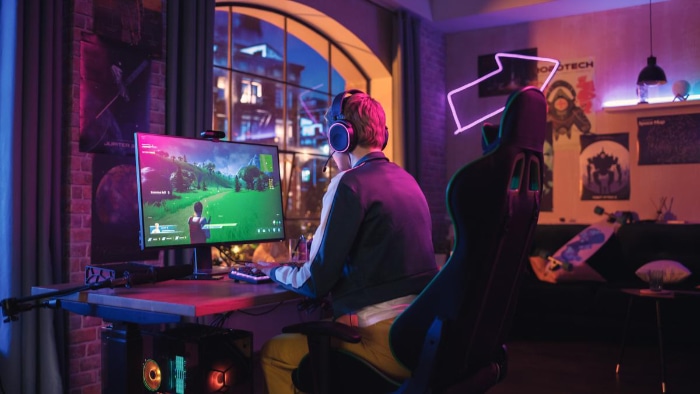What Is Post-Processing in Video Games? The Real Impact

Video game graphics are a blend of artistry and technology, crafting immersive digital realms that captivate players. Central to this allure is a lesser-known technique called post-processing, which finesses each frame to elevate the visual aesthetics of a game.
As players dive into vibrant landscapes, embark on thrilling quests, or engage in intense combat, post-processing subtly works its magic in the background, ensuring every moment is visually stunning. But what exactly is this pivotal process, and how does it transform our gaming experiences?
Defining Post-Processing
In the world of video games, post-processing is like the icing on the cake. While the basic graphical output sets the scene, post-processing takes it a notch higher, adding layers of refinement and allure.
But what exactly is post-processing, and how does it operate in a gaming context?
What Is Post-Processing?
Post-processing refers to the techniques used to alter an already rendered image with the intent of improving its visual quality. Unlike primary rendering methods, which deal with models, textures, and lighting, post-processing works on the final image that is displayed on the screen.
These alterations can range from subtle enhancements to dramatic changes, all aimed at achieving a particular visual or emotional impact.
Core Mechanics
The core mechanics of post-processing are built upon the manipulation of pixels. After the initial scene has been rendered, various algorithms and shaders work on individual pixels or groups of pixels to alter their properties.
These can include changes to color, brightness, contrast, and more. Importantly, the process is usually carried out in real-time during gameplay, meaning it must be optimized for efficiency to avoid hampering the game's performance.
Common Techniques
When discussing post-processing, certain effects frequently come to the forefront:
- Bloom – Adds a soft glow to bright areas, making light sources appear more natural.
- Depth of Field – Blurs objects that are either too close or too far from the camera, focusing the player's attention where it's needed.
- Anti-aliasing – Smoothes out jagged edges, providing a cleaner look to objects.
- Motion Blur – Adds a trailing effect to fast-moving objects, enhancing the perception of speed and fluidity.
- Color Grading – Alters the overall color scheme of a scene, usually to establish mood or setting.
Contextual Applications
Post-processing doesn't exist in a vacuum. It is often employed in a contextual manner, serving specific functions in the game.
For example, a sepia filter might be used during a flashback sequence to signify that the events are taking place in the past. Or a sharpening effect might be applied when a player uses a skill that heightens their senses.
Objective and Subjective Impact
The ultimate goal of post-processing is to improve the visual quality of a game, but “improvement” can be both objective and subjective. Objectively, techniques like anti-aliasing provide a measurable upgrade in the graphical fidelity.
Subjectively, effects like color grading can evoke specific emotions or add an artistic touch, the value of which may vary from player to player.
How Post-Processing Enhances Gaming Experience
While post-processing's primary purpose is to refine visuals, its influence extends far beyond mere aesthetics. It impacts player psychology, storytelling, and even gameplay mechanics, turning it into a multifaceted tool for enhancing the overall gaming experience.
Psychological Impact
A game's visuals serve as a window to its virtual world, and how clear, atmospheric, or lifelike this window appears can significantly impact the player's psychological experience. Post-processing helps in creating mood or atmosphere through effects like fog, rain, or ethereal glows. These not only make the game world more immersive but also influence how players feel—whether they're more relaxed, anxious, or alert.
Storytelling Device
In the realm of interactive storytelling, post-processing is akin to the camera techniques used in film and television. Different filters or visual effects can indicate different timelines, locations, or emotional states.
For example, greyscale could signify a memory, or a dreamy glow might be used for magical or surreal moments. By doing so, post-processing becomes a silent narrator, guiding players through a story without explicit exposition.
Gameplay Enhancement
Subtle cues are often critical for gameplay, and post-processing can serve as an effective tool for guiding players without being overt. Enhanced lighting can point towards an exit or object of interest, while focus effects can make certain interactive elements stand out.
When used wisely, these cues become integral to the game mechanics, helping players make informed choices without disrupting their sense of immersion.
Realism and Artistic Expression
Realism in video games is often a point of discussion, especially concerning how close digital environments come to replicating real-world physics and visuals. Post-processing techniques like ambient occlusion and advanced shadowing contribute to this by adding depth and realism to objects and environments.
On the flip side, post-processing can also enable artistic expression, allowing developers to break away from realism in favor of a more stylized, artistic vision.
Player Customization
Many modern games come with settings that allow players to tweak post-processing effects according to their preferences. This level of customization lets players optimize for performance or modify visuals to suit their aesthetic taste, making the game more accessible and enjoyable for a wider audience.
Types of Post-Processing Effects

When it comes to sprucing up a game's visuals, developers have a rich palette of post-processing effects at their disposal. Each effect serves a specific purpose, either improving the visual fidelity of the game, contributing to its storytelling, or enhancing its gameplay elements.
Bloom
Bright lights and glowing elements are staples in digital environments. Bloom helps in making these elements look softer and more natural by spreading light from the bright regions to adjacent pixels.
This creates an atmospheric halo around light sources, lending a sense of realism to the game.
Depth of Field
Just as with camera lenses, depth of field in video games serves to focus the player's attention on a specific area or object, blurring out the less important background or foreground. This effect not only adds a cinematic quality but can be used to guide players subtly towards an objective or point of interest.
Anti-aliasing
Pixelation or jagged edges can break the immersion by revealing the artificial nature of the game world. Anti-aliasing smoothens these rough edges by averaging pixel colors, providing a cleaner and more polished look to objects and characters.
The result is a more lifelike visual representation.
Motion Blur
In fast-paced sequences or games, motion blur can contribute to a more fluid perception of movement. It adds a trailing effect to objects or settings in swift motion, mimicking the way our eyes perceive rapid activities.
While it may not be everyone's cup of tea, when done correctly, motion blur can add an extra layer of realism.
Color Grading
Colors evoke moods, set the atmosphere, and can even contribute to storytelling. Color grading is the technique of altering the color scheme of the entire scene to achieve these purposes.
Whether it's a warm, sunset glow for a relaxed setting or a cold, blue tint for a tension-filled scene, color grading can significantly impact the player's emotional experience.
Ambient Occlusion
Shadows lend depth and dimensionality to digital spaces, making them look less flat and more realistic. Ambient occlusion calculates how exposed each point in a scene is to ambient lighting and adjusts the shadowing accordingly.
This adds an extra layer of depth, making the game environment appear more three-dimensional.
Lens Flare
Simulating the effect of light scattered within a camera lens, lens flare is often used to dramatize bright light sources and reflections. Although it doesn't add to realism—since human eyes don't perceive lens flare the way cameras do—it can serve to heighten dramatic or cinematic moments in a game.
Advantages and Limitations
Post-processing serves as a powerful tool in the arsenal of game developers, but like any tool, it has its strengths and weaknesses. While it can dramatically elevate the visual and emotional appeal of a game, it also comes with technical challenges and potential drawbacks.
Advantages
Visual Enhancement
One of the most straightforward benefits is the visual enhancement it provides. From smoothing out jagged edges with anti-aliasing to adding emotional depth with color grading, post-processing can transform a game from visually adequate to stunning.
Cinematic Quality
Effects like depth of field and lens flare can bring a cinematic quality to games, aiding in storytelling and emotional engagement. These effects make scenes more compelling and can elevate the overall player experience.
Real-Time Flexibility
Since most post-processing effects are applied in real-time, they offer a level of flexibility that's hard to achieve through other means. This allows for dynamic changes in visual style or atmosphere, which can be keyed to gameplay events, player choices, or narrative developments.
Player Customization
Providing players with the option to adjust post-processing settings can make the game more accessible. Whether they're optimizing for performance or tailoring the aesthetic to their liking, player customization adds an extra layer of personalization to the gaming experience.
Limitations
Performance Cost
The most evident drawback of post-processing is the toll it takes on system resources. High-quality effects can be demanding, leading to decreased frame rates and increased load times, particularly on older or less capable hardware.
Artistic Cohesion
While the variety of effects is an asset, it can also be a potential pitfall. Overuse or inappropriate use of post-processing can lead to a visually chaotic or inconsistent experience, detracting from the game's artistic cohesion.
Potential for Distraction
Although designed to enhance, certain effects can sometimes distract or detract from gameplay. For example, excessive motion blur may make fast-paced games harder to navigate, or overly dramatic bloom might obscure important details in the game world.
Lack of Universality
Not all post-processing effects are universally appreciated or effective. What some players find immersive or aesthetically pleasing, others might find distracting or even nauseating.
Developers need to strike a delicate balance to accommodate a broad audience.
Real-world Examples

Examining real-world examples can offer valuable insights into the impact and effectiveness of post-processing effects in video games. These case studies serve to illustrate how developers have leveraged various post-processing techniques to achieve specific aesthetic, emotional, and gameplay goals.
The Witcher 3: Wild Hunt
This award-winning role-playing game is often praised for its atmospheric visuals, and post-processing plays a significant role in achieving this effect. The game's use of bloom creates a dreamlike quality around light sources, particularly during sunset or sunrise.
Moreover, ambient occlusion and advanced shadowing contribute to the realistic portrayal of the medieval world, enriching the overall gaming experience.
Red Dead Redemption 2
Red Dead Redemption 2 is a showcase of visual realism, and post-processing effects like depth of field and color grading are crucial contributors. These techniques add a filmic quality to the game, further enhancing its storytelling power.
For instance, the depth of field subtly directs player attention during crucial moments, while the color grading changes in various geographical and chronological settings to match the mood.
Fortnite
As a game that leans towards a more stylized, cartoonish visual approach, Fortnite makes ample use of post-processing to match its aesthetic goals. The game employs vibrant color grading to maintain its energetic atmosphere, and its use of anti-aliasing ensures that the game looks smooth even when running at lower resolutions or on less powerful hardware.
Resident Evil 7: Biohazard
This survival horror title uses post-processing effects to ramp up the tension and fear. Effects like fog and dark shadows generated through ambient occlusion create an environment that feels oppressive and hazardous.
These elements don't just look scary; they also affect gameplay by making it harder to spot threats, thus increasing the emotional stakes.
Sekiro: Shadows Die Twice
Here, post-processing serves a practical gameplay function in addition to its aesthetic role. Subtle cues, like the light guiding the player towards an objective, are vital for the gameplay.
These cues, enhanced by carefully tuned lighting effects, help players navigate the world without the need for obtrusive UI elements or arrows.
Conclusion
Post-processing effects have firmly established themselves as essential components in the toolkit of video game developers. Whether aiming for photorealistic landscapes or a stylized, otherworldly atmosphere, these techniques offer a multitude of ways to enhance visual storytelling and gameplay.
Through their advantages in boosting visual quality and cinematic immersion, as well as their limitations in performance costs and artistic risks, post-processing stands as a double-edged sword that requires thoughtful implementation. Real-world examples like The Witcher 3 and Fortnite demonstrate the breadth of post-processing's applications, making it abundantly clear that its role in shaping the gaming experience is both significant and nuanced.


